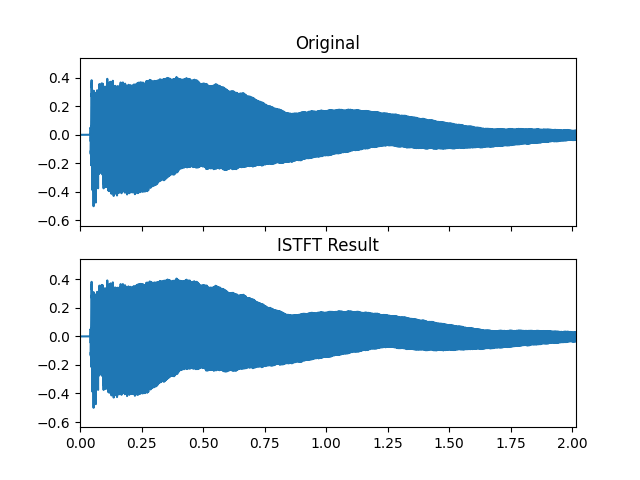STFT - Short Time Fourier Transform
- class audioflux.STFT(radix2_exp=12, window_type=WindowType.RECT, slide_length=1024)
Short-time Fourier transform (STFT).
- Parameters
- radix2_exp: int
fft_length=2**radix2_exp- window_type: WindowType
Window type for each frame.
See:
type.WindowType- slide_length: int
Window sliding length.
See also
Examples
Read 220Hz audio data
>>> import audioflux as af >>> audio_path = af.utils.sample_path('220') >>> audio_arr, sr = af.read(audio_path)
Compute stft and istft
>>> stft_obj = af.STFT(radix2_exp=12, window_type=af.type.WindowType.RECT, slide_length=1024) >>> spec_arr = stft_obj.stft(audio_arr) >>> new_audio_arr = stft_obj.istft(spec_arr)
Show plot
>>> import matplotlib.pyplot as plt >>> fig, ax = plt.subplots() >>> ax.set_title('STFT Spectrogram') >>> img = af.display.fill_spec(np.abs(spec_arr), axes=ax, >>> y_coords=stft_obj.y_coords(sr), >>> x_coords=stft_obj.x_coords(audio_arr.shape[-1], sr), >>> y_axis='log', x_axis='time') >>> fig.colorbar(img, ax=ax)
>>> fig, axes = plt.subplots(nrows=2, sharex=True, sharey=True) >>> ax = af.display.fill_wave(audio_arr, axes=axes[0]) >>> ax.set_title('Original') >>> ax = af.display.fill_wave(new_audio_arr, axes=axes[1]) >>> ax.set_title('ISTFT Result')


Methods
cal_data_length(time_length)Calculate the length of the audio data from the frame length.
cal_time_length(data_length)Calculate the length of a frame from audio data.
enable_padding([flag])Whether to enable padding.
Get window data array.
istft(m_data_arr[, method_type])Calculate ISTFT (Inverse Short-Time Fourier Transform) data.
set_padding([position_type, mode_type, ...])Set padding parameters.
set_slide_length(slide_length)Set the slide length.
stft(data_arr)Calculate STFT (Short-Time Fourier Transform) data.
use_window_data_arr(data_arr)Custom window data array.
x_coords(data_length[, samplate])Get the X-axis coordinate
y_coords([samplate])Get the Y-axis coordinate
- set_slide_length(slide_length)
Set the slide length.
- Parameters
- slide_length: int
Window sliding length.
- set_padding(position_type=PaddingPositionType.CENTER, mode_type=PaddingModeType.CONSTANT, value1=0.0, value2=0.0)
Set padding parameters.
Before calling this function, you must use enable_padding and set is_pad to True.
- Parameters
- position_type: PaddingPositionType
Padding position type.
See:
type.PaddingPositionType- mode_type: PaddingModeType
Padding mode type.
See:
type.PaddingModeType- value1: float
Padding value1.
If mode_type is CONSTANT and position_type is CENTER, value1 is the left padding value, length is fft_length // 2. If mode_type is CONSTANT and position_type is LEFT, value1 is the left padding value, length is fft_length // 2. If mode_type is CONSTANT and position_type is RIGHT, value1 is the right padding value, length is fft_length // 2. Other modes are not used.
- value2: float
Padding value2.
If mode_type is CONSTANT and position_type is CENTER, value2 is the right padding value, length is fft_length // 2. Other modes are not used.
- Returns
- use_window_data_arr(data_arr)
Custom window data array.
Default window data array is generated by window_type.
- Parameters
- data_arr: np.ndarray [shape=(fft_length,)]
Window data array.
- Returns
- get_window_data_arr()
Get window data array.
- Returns
- out: np.ndarray [shape=(fft_length,)]
Window data array.
- enable_padding(flag=False)
Whether to enable padding.
Default is False.
- Parameters
- flag: bool
Whether to enable padding.
- Returns
- cal_time_length(data_length)
Calculate the length of a frame from audio data.
fft_length = 2 ** radix2_exp(data_length - fft_length) // slide_length + 1
- Parameters
- data_length: int
The length of the data to be calculated.
- Returns
- out: int
- cal_data_length(time_length)
Calculate the length of the audio data from the frame length.
- Parameters
- time_length: int
The length of the frame to be calculated.
- Returns
- out: int
- stft(data_arr)
Calculate STFT (Short-Time Fourier Transform) data.
- Parameters
- data_arr: np.ndarray [shape=(…, n)]
Input audio data
- Returns
- out: np.ndarray [shape=(…, fft_length // 2 + 1, time_length), dtype=np.complex64]
STFT data
- istft(m_data_arr, method_type=0)
Calculate ISTFT (Inverse Short-Time Fourier Transform) data.
- Parameters
- m_data_arr: np.ndarray [shape=(…, fft_length // 2 + 1, time_length), dtype=np.complex64]
Input STFT data
- method_type: int
0: weight(default) 1: overlap-add
- Returns
- out: np.ndarray [shape=(…, data_length), dtype=np.float32]
ISTFT data
- y_coords(samplate=32000)
Get the Y-axis coordinate
- Parameters
- samplate: int
Sampling rate of the incoming audio.
- Returns
- out: np.ndarray [shape=(fre,)]
- x_coords(data_length, samplate=32000)
Get the X-axis coordinate
- Parameters
- data_length: int
The length of the data to be calculated.
- samplate: int
Sampling rate of the incoming audio.
- Returns
- out: np.ndarray [shape=(time,)]